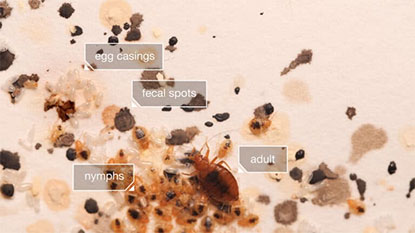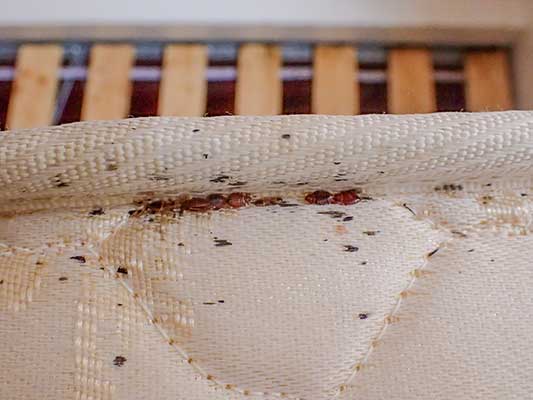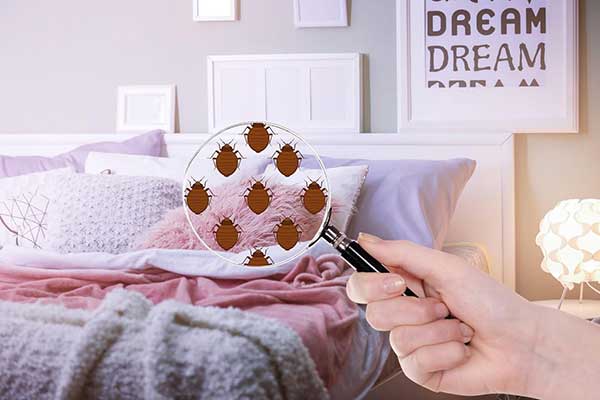Bed bugs are some of the most invasive and persistent pests that you could deal with. The small, reddish-brown, and oval-shaped insects feed on animal and human blood. Their size and body shape allow them to fit in the tiniest places, and since they are nocturnal, they are tough to detect. Although the CDC says that these pests don’t carry any bacteria or transmit any disease, these parasites will deprive you of your much-deserved sleep with their itchy and irritating bites. This will lead most folks to scour the internet on “how do to tell if you have bed bugs?”
Experts warn that homeowners should take swift action once they discover that their residence is bed bug infested. However, most people’s bugging question is, “how do to tell if you have bed bugs yet they come out to feed at night?” If you suspect that these pesky creatures have invaded your house, there are signs that you can use as a checklist when doing your own inspection.
7 Signs of a Possible Bed Bug Infestation
Rusty Stains and Blood Spots on Your Beddings
Bed bugs might be the sneakiest pests ever, but they don’t always get away unscathed. The first thing that points to bed bug infestation is rust-colored stains or blood on your beddings. When adjusting your position as you sleep, you may crush a bug that’s already full, thereby spilling its content and staining your sheets. If you repeatedly find bloodstains on your sheets even after changing them, this might indicate that you have bed bugs.
Bed Bug Eggs

The second thing that might indicate a possible bed bug infestation is eggs near your sleeping area or anywhere in the house. Female bed bugs lay between one and seven eggs daily. As such, it is possible to find these eggs stuck in crevices or cracks near the bed or any other place.
Bed bug eggs are 1mm long, pearl white, and oval-shaped. Since female bed bugs like to wander when pregnant, they may scatter the eggs in various points, including neighboring apartments. It is easy to miss the eggs with your naked eyes since they are too small. However, these pests lay them in a cluster, and you can often spot them stuck on the underside of your bed.
Bites
Several pests inflict bites that are painful and itchy, including bed bugs. The first sign that you might be sharing your home with these pests is the presence of itchy bites on your skin. They inflict bites that can lead to flat itchy, reddish welts. However, most experts argue that this is not a reliable way to identify bed bugs.
For starters, some people claim that you can know bed bug bites from how they are arranged (a straight line of 3), but this may not always be the case, as they may change the pattern. Secondly, people react differently to the bites, so there’s no standard way to know if a bed bug bite brought a particular reaction. Lastly, the side effects from a bed bug bite are not immediate, and some people may start to experience an allergic reaction with bed bugs’ saliva after one day.
Fecal Marks

Since bed bugs only feed on blood, they leave characteristic fecal marks on any material they rest on. In short, the parasites have fecal patterns that smear in a very distinct fashion. Their fecal matter is dark and small and resembles magic matter stains on fabric when pressed.
Shells
For a bed bug to mature into adulthood, it undergoes five life cycle stages. Before moving to the next stage, a bed bug feeds on a full-blood meal and sheds its exoskeleton. As a homeowner, you may find these shell casings littered around the bedroom. If you often see these translucent and hollow exoskeletons in your house, it may indicate severe infestation.
A Characteristic Odor
Bed bugs are known to emit pheromones with a slightly sweet, musty smell. Most people claim that the odor resembles raspberries, but others claim that it smells more like coriander. However, this is one of the least helpful signs because, by the time the odor is powerful enough to be detected by the homeowner, the infestation will have progressed to a more advanced stage. You’ll have noticed more apparent signs before the odor.
Most Obvious How To Tell If You Have Bed Bugs: Live Bed Bugs
The most apparent and obvious sign of an infestation is finding a live bed bug in your home. However, finding a live bed bug is one of the most challenging tasks since these creatures are private and only appear to feed at night when you’re dead asleep. Unless the bugs are starving for months or pregnant, it’s unlikely to find it wandering around. Also, homeowners should know how to distinguish features to avoid confusing bed bugs with other insects.
First, they are oval-shaped, have a narrow head, and thorax with an expansive abdomen. They have two antennae that have four segments. Adults have a rusty-brownish look but are reddish after feeding. They have vestigial front wings but can’t fly.
Where Do Bed Bugs Hide?
Often bed bugs like to stay in well-protected areas in your home. However, you’ll always find them close to where you spend much of your time. The small, flattened bodies allow them to get into tiny places that you may not suspect. If you think that there are bed bugs in your house, these are the areas you should inspect:
- Between the mattress covers and in pillow threads
- Crevices and cracks on the bed frame and headboards
- In the seams or tags of mattresses, couches, and chairs
- Under the folds of drapes or curtains
- Inside electrical appliances and receptacles
- Around the junctions, edges, and corners of walls and ceilings
- Under loose wallpaper or wall hangings
What to Do When You Discover That Your Residence is Bed Bug-Infested?
Once you discover bed bugs in your home, the first thing you should do is get rid of all contaminated items and then clean everything with bed bugs, including the rooms. You can then apply a pesticide to help lower their population. This is typically the first reaction once homeowners get through the check list of “how do to tell if you have bed bugs.” The most crucial step is to contact a professional exterminator to help you eradicate the bed bugs from your house for good.
It’s close to impossible to exterminate all pests from your residence without professional help. Usually, bed bugs require a strategic approach that incorporates several steps for them to be banished entirely from your home. For this reason, it is crucial to involve professionals who have passed through rigorous training on exterminating these pesky pests.


